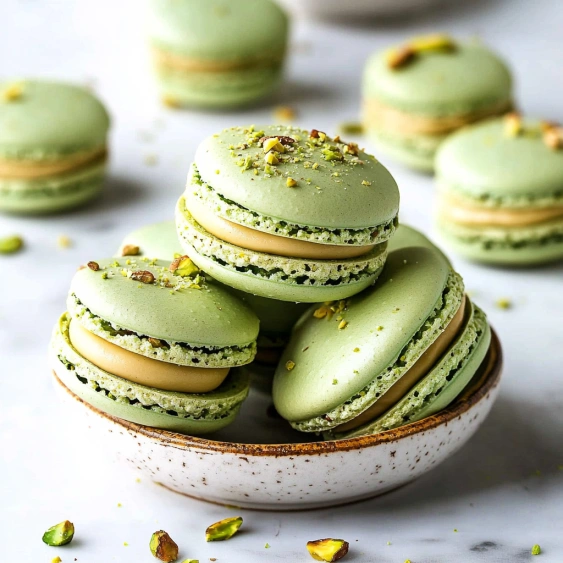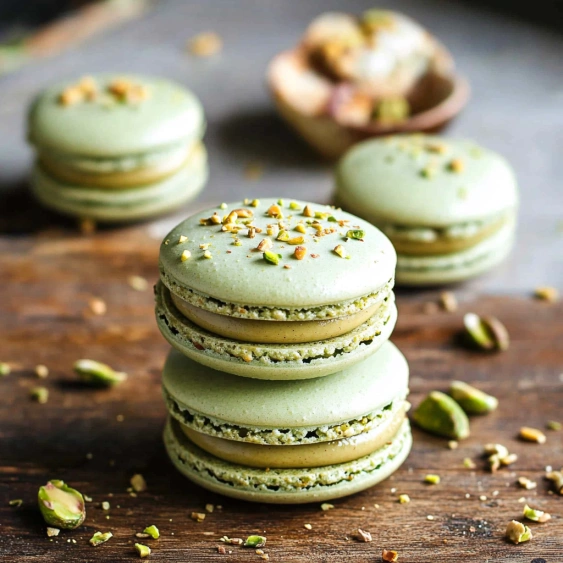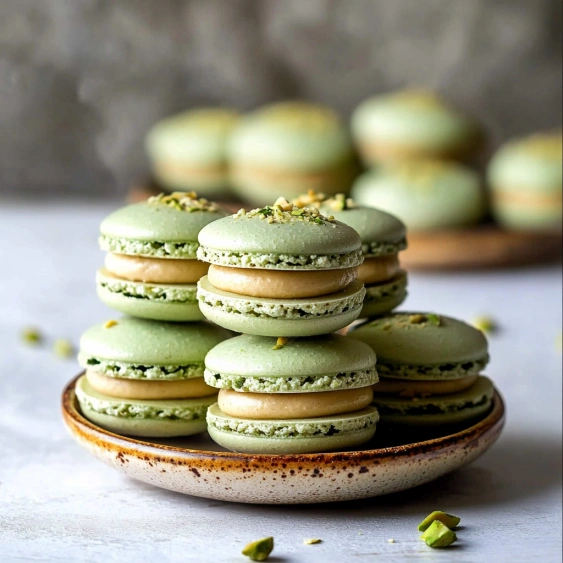 Pin it
Pin it
This pistachio macaron recipe transforms simple ingredients into elegant French pastries with a delightful nutty twist. The combination of almond and pistachio flours creates a unique flavor profile that elevates these treats beyond traditional macarons, while the cream cheese filling adds a perfect creamy contrast to the crisp shells.
I perfected this recipe after numerous attempts at getting that elusive macaron texture just right. The first time I served these at a family gathering, everyone thought I had purchased them from a fancy patisserie rather than made them in my home kitchen.
Ingredients
- Egg whites: room temperature for optimal volume
- Granulated sugar: creates the glossy meringue base
- Almond flour: provides the classic macaron texture
- Pistachio flour: adds distinctive nutty flavor
- Powdered sugar: contributes sweetness and structure
- Green food coloring: enhances visual appeal optional but recommended
- Cream cheese: makes the filling luxuriously smooth
- Butter: adds richness to the filling
- Vanilla extract: balances the nutty pistachio notes
- White chocolate drizzle: creates an elegant finishing touch
Step-by-Step Instructions
- Preparation:
- Begin by gathering all ingredients measured precisely with a kitchen scale for accuracy. Precision is crucial for successful macarons. Sift the powdered sugar, almond flour, and pistachio flour together to remove any lumps that could disrupt the smooth texture of your shells.
- Create Sugar Syrup:
- Place egg whites and granulated sugar in a bowl over simmering water bath, ensuring the bowl doesn't touch the water. Whisk continuously until sugar completely dissolves and mixture feels smooth between your fingers with no gritty texture. This process creates a more stable meringue that will hold its shape.
- Whip To Perfection:
- Transfer the warm egg white mixture to a stand mixer. Begin whisking on low speed for about 30 seconds, then gradually increase to medium for 1 to 2 minutes until the mixture turns white and fluffy. Finally raise to high speed and whip until stiff glossy peaks form. You should see distinct whisk marks in the meringue, and when you lift the whisk, the peak should stand upright with perhaps only a slight bend at the tip.
- Macaronage Technique:
- Add the sifted dry ingredients and food coloring to the meringue. Fold gently using a J motion, scraping the sides and cutting through the middle. The macaronage stage is critical. Test readiness by drawing a figure 8 with the batter without it breaking. The batter should flow like lava, slowly but continuously from the spatula.
- Pipe With Precision:
- Transfer batter to a piping bag fitted with a round tip. Hold bag perpendicular to baking sheet and pipe 1.5inch circles, applying even pressure for about 3 seconds before lifting with a quick twist. Leave space between each macaron for spreading.
- Rest And Release:
- Bang the trays firmly against the counter several times to release air bubbles. Use a toothpick to pop any visible bubbles on the surface. Allow the piped shells to rest until they develop a dry skin that feels tacky but not sticky when gently touched, approximately 20 to 40 minutes depending on humidity.
- Bake With Vigilance:
- Bake at 300°F for 15 to 20 minutes, rotating the tray halfway through. Properly baked macarons will have developed feet the frilly bottom edge and will feel stable when gently touched. They should not be jiggly or soft in the center.
- Create Pistachio Filling:
- Beat softened cream cheese and butter until smooth. Incorporate sifted powdered sugar, pistachio flour, and vanilla until creamy and fluffy. The filling should hold its shape when piped but remain soft enough to bite through easily.
- Assemble With Care:
- Pipe filling onto flat sides of half the shells and sandwich with remaining shells. Apply gentle pressure to spread filling to edges without cracking the delicate shells. Drizzle with melted white chocolate and sprinkle with ground pistachios for an elegant finishing touch.
 Pin it
Pin it
Pistachio flour was my game changer in this recipe. I discovered it after years of making standard macarons and the depth of flavor it adds is incomparable. My daughter now requests these for her birthday instead of cake each year, which feels like the ultimate baking compliment.
Troubleshooting Macaron Problems
Hollow shells often result from undermixed batter or oven temperature being too high. Try folding the batter a few more times or reducing your oven temperature by 5 to 10 degrees. The perfect macaron has a slight chew with no large air pockets inside.
Cracked tops typically indicate insufficient resting time before baking. Humidity greatly affects how quickly macaron shells develop the necessary skin. On particularly humid days, you may need to extend resting time to an hour or more. If shells still crack, try resting them near a fan to expedite drying.
No feet developing suggests either overmixed batter or insufficient drying time. The characteristic ruffled edge forms when the trapped air in properly mixed batter has nowhere to escape except upward during baking. Always ensure shells have formed a dry skin before baking.
Making Ahead And Storage
Assembled macarons actually improve with flavor after 24 hours of refrigeration. This maturation period allows the shells to soften slightly and flavors to meld. Store them in an airtight container in the refrigerator for up to 5 days, bringing to room temperature for 20 minutes before serving for best texture and flavor.
Unfilled shells can be stored in an airtight container at room temperature for 2 days or frozen for up to 3 months. The filling can be refrigerated separately for up to 5 days. This makes macarons an excellent make ahead dessert for special occasions.
Pistachio Flour Tips
You can make homemade pistachio flour by finely grinding raw unsalted pistachios in a food processor. Pulse rather than running continuously to prevent releasing oils. Sift after grinding and return any larger pieces to the processor for additional grinding.
Commercial pistachio flour provides more consistent results but is more expensive. If using homemade, allow slightly more resting time for your macaron shells as the natural oils can affect drying time. The flavor difference is worth the extra effort.
 Pin it
Pin it
Frequently Asked Questions
- → What is pistachio flour and how can I make it?
Pistachio flour is finely ground pistachios. To make it at home, pulse shelled unsalted pistachios in a food processor until they reach a fine, flour-like consistency. Be careful not to over-process or they'll turn into pistachio butter. Sift the ground pistachios to remove larger pieces for the smoothest texture in your macarons.
- → Why do my macarons need to rest before baking?
The resting period (20-40 minutes) allows the macaron shells to develop a dry surface while remaining soft inside. This dry skin is essential for proper 'feet' formation during baking. In humid environments, you might need a longer resting time. You'll know they're ready when you can gently touch the surface and no batter sticks to your finger.
- → How can I prevent hollow macaron shells?
To prevent hollow shells: properly whip your meringue to stiff peaks (not over-whipped); fold the batter to the right consistency (the figure-8 test); properly dry shells before baking; bake at the correct temperature; and allow macarons to fully cool on the baking sheet. Proper macaronage (folding technique) is especially crucial for solid shells.
- → Can I make macarons without a stand mixer?
Yes, you can make macarons without a stand mixer by using a hand mixer instead. The process remains the same - whip the egg whites and sugar to stiff peaks, then fold in the dry ingredients. It might take slightly longer with a hand mixer, and you'll need to be careful not to underwhip the meringue. The main challenge will be achieving the proper stiff peak consistency.
- → How long do pistachio macarons stay fresh?
Pistachio macarons actually improve after 24-48 hours in the refrigerator as the flavors meld and the texture softens. Once assembled, they'll stay fresh in an airtight container in the refrigerator for up to 1 week. They can also be frozen for up to 3 months. For best flavor, bring to room temperature before serving.
- → Why did my macaron shells crack during baking?
Cracked shells typically result from insufficient drying time before baking (shells need a dry surface), air bubbles trapped in the batter (tap the trays firmly on the counter after piping), oven temperature too high (use an oven thermometer to verify), or overmixed batter. Ensure you're letting the piped shells rest until they form a skin and use a toothpick to pop any visible air bubbles.
